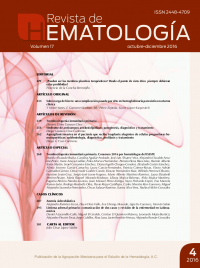Resumen
Con frecuencia, las recomendaciones de las guías extranjeras no pueden aplicarse en México, por carencia de recursos o por diferencias culturales de médicos y pacientes, costumbres arraigadas, distinto acceso a la información, diferentes condiciones de alimentación y vivienda, entre otras. Pueden hacerse modificaciones a los esquemas recomendados, que reducen los gastos, pero sin perder la eficacia terapéutica. Desde la aparición de la Medicina basada en la evidencia, en el decenio de 1980, las guías de práctica clínica se han vuelto herramientas importantes para marcar el estándar de calidad y atención de los pacientes. La creciente influencia de las directrices ha despertado un escrutinio progresivo de los métodos de elaboración de éstas porque deben divulgar las ventajas y limitaciones con base en la evidencia científica disponible.
Palabras clave: guías de práctica clínica, trombocitopenia inmunitaria primaria, cuenta plaquetaria hemostática, esplenectomía.
Abstract
Often, the recommendations of foreign guidelines may be applied in Mexico, both by lack of resources such as cultural differences of doctors and patients, entrenched customs, different access to information, different conditions of food and housing, among other. Sometimes modifications can be made to the recommended schemes that reduce costs without losing therapeutic effectiveness. Since the emergence of evidence-based medicine in the 1980, the clinical practice guidelines have become increasingly important tools to set the standard for quality and patient care. The growing influence of the guidelines has attracted scrutiny progressive development of these methods, since they must disclose the advantages and limitations based on the available scientific evidence. Over the last two classification systems decades force recommendations they have evolved, becoming more sophisticated.
Keywords: Clinical Practice Guidelines; primary immune thrombocytopenia; hemosthatic platelet count; splenectomy

